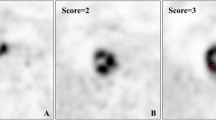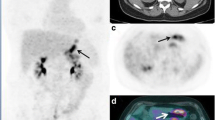Abstract
Purpose
The use of 18F-fluoro-deoxyglucose positron emission tomography/computed tomography (FDG-PET/CT) in primary gastric lymphoma (PGL) is challenging due to physiologic FDG activity in the stomach and variability in the degree of uptake in various histologic subtypes. This study assesses FDG avidity and PET/CT patterns in newly diagnosed PGL.
Methods
Sixty-two PET/CT studies of newly diagnosed PGL were reviewed (24 low-grade mucosa-associated lymphoid tissue [MALT], 38 aggressive non-Hodgkin’s lymphoma [AGNHL]). FDG avidity, patterns (focal/diffuse), and intensity (visually vs. the liver and SUVmax) were assessed and compared to 27 controls. Gastric CT abnormalities and extragastric sites were recorded.
Results
Gastric FDG uptake was found in 55/62 (89%) PGL (71% MALT vs. 100% AGNHL, p < 0.001) and 63% controls. A diffuse pattern was found in 60% PGL (76% MALT vs. 53% AGNHL, p = NS) and 47% controls. FDG uptake higher than liver was found in 82% PGL (58% MALT vs. 97% AGNHL, p < 0.05) and 63% controls. SUVmax in FDG-avid PGLs was 15.3 ± 11.7 (5.4 ± 2.9 MALT vs. 19.7 ± 11.5 AGNHL, p < 0.001) and 4.6 ± 1.4 in controls. CT abnormalities were found in 79% PGL (thickening, n = 49; ulcerations, n = 22). Extra-gastric FDG-avid sites were seen in none of MALT, but 61% of AGNHL (nodal, n = 18; nodal and extranodal, n = 5).
Conclusions
FDG avidity was present in 89% of PGLs, including all patients with AGNHL but only 71% of MALT. FDG uptake can be differentiated, in particular in AGNHL-PGL, from physiologic tracer activity by intensity but not by pattern. Extragastric foci on PET and structural CT abnormalities are additional parameters that can improve PET/CT assessment of PGL. Defining FDG avidity and PET/CT patterns in AGNHL and a subgroup of MALT-PGL before treatment may be important for further monitoring therapy response.



Similar content being viewed by others
References
D’Amore F, Brincker H, Gronbaek K, Thorling K, Pedersen M, Jensen MK, et al. Non-Hodgkin’s lymphoma of the gastrointestinal tract: a population-based analysis of incidence, geographic distribution, clinicopathological presentation features and prognosis. Danish Lymphoma Study Group. J Clin Oncol 1994;12:1673–84.
Akwaa A, Siddiqui N, Al-Mofleh I. Primary gastric lymphoma. World J Gastroenterol 2004;10:5–11.
Zucca E, Conconi A, Cavalli F. Treatment of extranodal lymphoma. Best Pract Res Clin Haematol 2002;15:533–47.
Al-Sheneber I, Shibata HR. Primary gastric lymphoma. Cancer Control J 1997;4:245–52.
Ambrosini V, Rubello D, Castellucci P, Nanni C, Farsad M, Zinzani P, et al. Diagnostic role of 18F-FDG PET in gastric MALT lymphoma. Nucl Med Review 2006;9:37–40.
Kumar R, Xiu Y, Potenta S, Mavi A, Zhuang H, Yu JQ, et al. 18F-FDG PET for evaluation of the treatment response in patients with gastrointestinal tract lymphomas. J Nucl Med 2004;45:1796–803.
Phongkitkarun S, Varavithya V, Kazama T, Faria S, Mar M, Podoloff D, et al. Lymphomatous involvement of the gastrointestinal tract: evaluation by positron emission tomography with (18)F-fluorodeoxyglucose. World J Gastroenterol 2005;11:7284–9.
Beal KP, Yeung HW, Yahalom J. FDG-PET scanning for detection and staging of extranodal marginal zone lymphomas of the MALT type: a report of 42 cases. Annals Oncology 2005;16:473–80.
Schöder H, Noy A, Gönen M, Weng L, Green D, Erdi YE, et al. Intensity of 18Fluorodeoxyglucose uptake in positron emission tomography. J Clin Oncol 2005;23:4643–51.
Hoffman M, Kletter K, Becherer A, Jager U, Chott A, Raderer M. 18F-fluoro-deoxyglucose positron emission tomography (18F-FDG-PET) for staging and follow-up of marginal zone B-cell lymphoma. Oncology 2003;64:336–40.
Even-Sapir E, Lievshitz G, Perry C, Herishanu Y, Lerman H, Metser U. Fluorine-18 fluorodeoxyglucose PET/CT patterns of extranodal involvement in patients with non-Hodgkin’s lymphoma and Hodgkin’s disease. PET Clin N Am 2006;1:251–63.
Metser U, Goor O, Lerman H, Naparstek E, Even-Sapir E. PET/CT patterns of extranodal lymphoma. Am J Roentgenol 2004;182:1579–86.
Maes B, De Wolf-Peeters C. Marginal zone cell lymphoma—an update on recent advances. Histopathology 2002;40:117–20.
Salvagno L, Sorarù M, Busetto M, Puccetti C, Sava C, Endrizzi L, et al. Gastric non-Hodgkin’s lymphoma: analysis of 252 patients from a multicenter study. Tumori 1999;85:113–21.
Author information
Authors and Affiliations
Corresponding author
Rights and permissions
About this article
Cite this article
Radan, L., Fischer, D., Bar-Shalom, R. et al. FDG avidity and PET/CT patterns in primary gastric lymphoma. Eur J Nucl Med Mol Imaging 35, 1424–1430 (2008). https://doi.org/10.1007/s00259-008-0771-8
Received:
Accepted:
Published:
Issue Date:
DOI: https://doi.org/10.1007/s00259-008-0771-8




